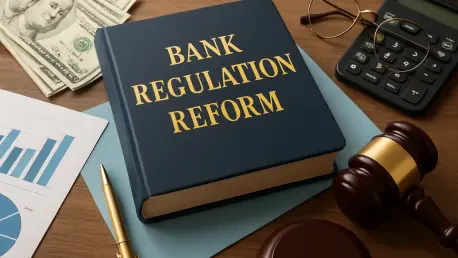In a significant development for the financial sector, the Office of the Comptroller of the Currency (OCC) and the Federal Deposit Insurance Corporation (FDIC) have unveiled two groundbreaking proposed rules aimed at reshaping bank supervision across the United States. Announced on October 7, these proposals seek to pivot regulatory focus from subjective considerations, such as reputation risk, toward objective, quantifiable financial risks. This shift marks a critical turning point in federal banking oversight, promising to bring greater clarity, consistency, and fairness to the evaluation and regulation of financial institutions. As banks navigate an increasingly complex regulatory landscape, these changes could redefine how they interact with examiners and manage compliance. The implications of this reform are far-reaching, potentially easing burdens on institutions while ensuring that the core focus remains on safeguarding financial stability. This article delves into the specifics of these proposals and their anticipated impact on the banking industry.
Redefining Unsafe Practices in Banking Supervision
The first proposed rule introduces a precise definition of what constitutes an “unsafe or unsound practice” under the Federal Deposit Insurance Act, aiming to anchor regulatory actions in measurable standards. Specifically, such a practice must deviate from prudent operational norms and either cause or be likely to cause material harm to a bank’s financial health or pose a substantial risk to the Deposit Insurance Fund. This rule also refines the issuance of Matters Requiring Attention (MRAs), restricting them to scenarios where conduct could reasonably escalate into unsafe practices under current or foreseeable conditions, or where a clear legal or regulatory violation exists. By tying examination downgrades directly to tangible safety-and-soundness risks, the proposal seeks to standardize supervisory communications. This change is poised to create a more predictable framework for banks, reducing ambiguity in how regulators assess compliance and operational integrity during evaluations.
Beyond defining unsafe practices, this rule emphasizes a shift toward objectivity in supervisory processes, which could significantly alter the regulatory burden on financial institutions. The focus on material financial risks over subjective judgment is intended to prevent overreach by examiners, ensuring that banks are evaluated based on concrete data rather than vague or inconsistent criteria. For many in the industry, this represents a long-overdue clarification of regulatory expectations, potentially minimizing disputes over supervisory findings. Furthermore, by limiting MRAs to critical issues, the rule may reduce the frequency of minor or speculative criticisms that often complicate bank operations. This streamlined approach not only aims to foster trust between regulators and institutions but also ensures that resources are directed toward addressing genuine threats to financial stability. As a result, banks may find it easier to align their practices with regulatory standards, knowing that oversight is grounded in clear, defensible metrics.
Eliminating Reputation Risk from Regulatory Focus
The second proposed rule takes a bold step by explicitly removing “reputation risk”—the risk of negative public perception unrelated to financial or operational health—from the supervisory framework. Under this rule, regulators are barred from criticizing or taking adverse actions against banks based on perceived reputational concerns. Additionally, examiners are prohibited from pressuring banks to open, close, or modify customer or third-party relationships due to political, social, cultural, or religious views, or lawful but politically disfavored activities. This provision directly addresses concerns about politically motivated “debanking” practices, ensuring that supervisory actions remain centered on financial stability rather than external societal pressures. For banks, this change could safeguard against unfair treatment driven by subjective biases, creating a more equitable regulatory environment.
While narrowing the scope of supervisory authority in certain areas, the rule carefully preserves the agencies’ ability to tackle specific risks under frameworks like the Bank Secrecy Act, anti-money laundering laws, and Office of Foreign Assets Control sanctions. However, it explicitly prevents these authorities from being used as a pretext to reintroduce reputation-risk considerations into oversight. This balance reflects a broader federal trend toward risk-based, objective supervision, aligning with Executive Order 14331, which emphasizes fair access to banking services. By excluding non-financial factors from regulatory decisions, the proposal aims to protect banks from undue external influence while maintaining rigorous oversight of critical compliance areas. This could reshape how banks manage customer relationships, free from the fear of regulatory repercussions tied to public opinion or political trends, fostering a focus on core financial metrics.
Shaping a Future of Fair and Objective Oversight
Reflecting on the transformative nature of these OCC and FDIC proposals, it’s evident that a new era of federal banking oversight has emerged with their introduction. These rules prioritize material financial risks over subjective or reputational concerns, setting a precedent for clarity and fairness in regulatory practices. By redefining unsafe practices and eliminating reputation risk as a supervisory factor, the agencies have taken decisive steps to streamline their approach, ensuring that banks face evaluations rooted in measurable data. This shift not only addresses long-standing concerns about inconsistent or politically driven oversight but also reinforces the importance of financial stability as the cornerstone of regulation. Looking ahead, stakeholders should actively engage with these standards, as they are likely to redefine examination processes and supervisory interactions. Banks and industry advocates are encouraged to assess how these changes impact operational strategies, preparing for a landscape where objective risk assessment drives regulatory accountability.









